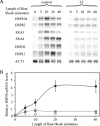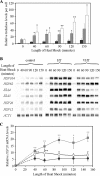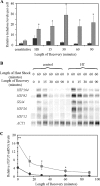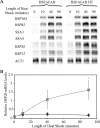The natural osmolyte trehalose is a positive regulator of the heat-induced activity of yeast heat shock transcription factor
- PMID: 17145780
- PMCID: PMC1800720
- DOI: 10.1128/MCB.01158-06
The natural osmolyte trehalose is a positive regulator of the heat-induced activity of yeast heat shock transcription factor
Abstract
In Saccharomyces cerevisiae, the intracellular concentration of trehalose increases rapidly in response to many environmental stresses, including heat shock. These high trehalose levels have been correlated with tolerance to adverse conditions and led to the model that trehalose functions as a chemical cochaperone. Here, we show that the transcriptional activity of Hsf1 during the heat shock response depends on trehalose. Strains with low levels of trehalose have a diminished transcriptional response to heat shock, while strains with high levels of trehalose have an enhanced transcriptional response to heat shock. The enhanced transcriptional response does not require the other heat-responsive transcription factors Msn2/4 but is dependent upon heat and Hsf1. In addition, the phosphorylation levels of Hsf1 correlate with both transcriptional activity and the presence of trehalose. These in vivo results support a new role for trehalose, where trehalose directly modifies the dynamic range of Hsf1 activity and therefore influences heat shock protein mRNA levels in response to stress.
Figures








Similar articles
-
Role of trehalose and heat in the structure of the C-terminal activation domain of the heat shock transcription factor.Proteins. 2005 Mar 1;58(4):826-35. doi: 10.1002/prot.20371. Proteins. 2005. PMID: 15651035
-
Saccharomyces cerevisiae heat shock transcription factor regulates cell wall remodeling in response to heat shock.Eukaryot Cell. 2005 Jun;4(6):1050-6. doi: 10.1128/EC.4.6.1050-1056.2005. Eukaryot Cell. 2005. PMID: 15947197 Free PMC article.
-
Regulation of the Hsf1-dependent transcriptome via conserved bipartite contacts with Hsp70 promotes survival in yeast.J Biol Chem. 2019 Aug 9;294(32):12191-12202. doi: 10.1074/jbc.RA119.008822. Epub 2019 Jun 25. J Biol Chem. 2019. PMID: 31239354 Free PMC article.
-
Regulation of the heat shock transcription factor Hsf1 in fungi: implications for temperature-dependent virulence traits.FEMS Yeast Res. 2018 Aug 1;18(5):foy041. doi: 10.1093/femsyr/foy041. FEMS Yeast Res. 2018. PMID: 29788061 Free PMC article. Review.
-
Size doesn't matter in the heat shock response.Curr Genet. 2017 May;63(2):175-178. doi: 10.1007/s00294-016-0638-7. Epub 2016 Aug 8. Curr Genet. 2017. PMID: 27502399 Free PMC article. Review.
Cited by
-
Soluble Sugar and Lipid Readjustments in the Yarrowia lipolytica Yeast at Various Temperatures and pH.Metabolites. 2019 Dec 17;9(12):307. doi: 10.3390/metabo9120307. Metabolites. 2019. PMID: 31861165 Free PMC article.
-
Artificial Fusion of mCherry Enhances Trehalose Transferase Solubility and Stability.Appl Environ Microbiol. 2019 Apr 4;85(8):e03084-18. doi: 10.1128/AEM.03084-18. Print 2019 Apr 15. Appl Environ Microbiol. 2019. PMID: 30737350 Free PMC article.
-
Drought-tolerant Sphingobacterium changzhouense Alv associated with Aloe vera mediates drought tolerance in maize (Zea mays).World J Microbiol Biotechnol. 2022 Oct 28;38(12):248. doi: 10.1007/s11274-022-03441-y. World J Microbiol Biotechnol. 2022. PMID: 36306019 Free PMC article.
-
Yeast Tolerance to Various Stresses Relies on the Trehalose-6P Synthase (Tps1) Protein, Not on Trehalose.J Biol Chem. 2015 Jun 26;290(26):16177-90. doi: 10.1074/jbc.M115.653899. Epub 2015 May 1. J Biol Chem. 2015. Retraction in: J Biol Chem. 2019 Apr 12;294(15):5812. doi: 10.1074/jbc.W119.008564. PMID: 25934390 Free PMC article. Retracted.
-
Biology of the heat shock response and protein chaperones: budding yeast (Saccharomyces cerevisiae) as a model system.Microbiol Mol Biol Rev. 2012 Jun;76(2):115-58. doi: 10.1128/MMBR.05018-11. Microbiol Mol Biol Rev. 2012. PMID: 22688810 Free PMC article. Review.
References
-
- Alexandre, H., L. Plourde, C. Charpentier, and J. Francois. 1998. Lack of correlation between trehalose accumulation, cell viability and intracellular acidification as induced by various stresses in Saccharomyces cerevisiae. Microbiology 144:1103-1111. - PubMed
-
- Amorós, M., and F. Estruch. 2001. Hsf1p and Msn2/4p cooperate in the expression of Saccharomyces cerevisiae genes HSP26 and HSP104 in a gene- and stress type-dependent manner. Mol. Microbiol. 39:1523-1532. - PubMed
-
- Arora, A., C. Ha, and C. B. Park. 2004. Inhibition of insulin amyloid formation by small stress molecules. FEBS Lett. 564:121-125. - PubMed
-
- Bell, W., P. Klaassen, M. Ohnacker, T. Boller, M. Herweijer, P. Schoppink, P. Van der Zee, and A. Wiemken. 1992. Characterization of the 56-kDa subunit of yeast trehalose-6-phosphate synthase and cloning of its gene reveal its identity with the product of CIF1, a regulator of carbon catabolite inactivation. Eur. J. Biochem. 209:951-959. - PubMed
Publication types
MeSH terms
Substances
Grants and funding
LinkOut - more resources
Full Text Sources
Other Literature Sources
Molecular Biology Databases
